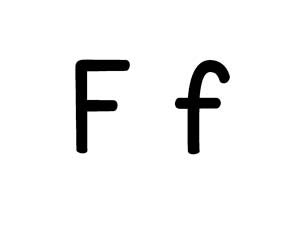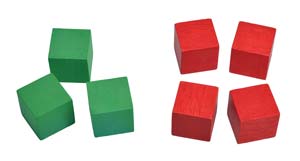Phonological awareness, Letter knowledge
Children will identify the initial sound of familiar words. Children also will understand the name and sound of the letter F.


Review:
Be Prepared: Use the following picture cards for today’s activity. If more cards are necessary, include cards used in Day 2:
B—bull, bed, bus, bug, bag, bib P—pig, pool, pan, paint M—mail, moon, map, magnet C—cup, cut, calf, cub, cast H—hip, hot, hill, hop, happy
We are going to play another beginning sound game today. Let me show you.
[Place picture cards B, C, P, M, and H face up on a table. Keep one card for yourself and give each child a card (see Be Prepared).]
I have a picture of a bull. I know that bull begins with the /b/ sound. Bull.
What letter makes the /b/ sound?
The letter B makes the /b/ sound. I will place my picture of a bull on top of the letter B. Now it is your turn to try!
[Invite each child to say the name of the picture on his/her card, determine the letter that makes the initial sound, and place his/her picture on the letter pile that matches the beginning letter sound of his/her picture.]
Now let’s play a funny name game.
We know that each of our names has a beginning sound. The name “Bill” begins with the /b/ sound.
A name can sound different without its beginning sound. If I took off the /b/ sound from the beginning of the name “Bill,” we would have the word “ill.” “Ill” is what is left of the name “Bill” when we take off the /b/ sound.
Let’s try another one. Let’s try the name “Daniel.” Let’s take off the /d/ sound from the beginning of the name “Daniel.”
If we took off the /d/ sound from the beginning of the name “Daniel,” what funny word would we have left? (aniel)
We would have the word “aniel.” This is a funny game!
Now let’s try our own names. I am going to say one of your names without its beginning sound. Let’s see if we can guess whose name I am saying. Raise your hand if you think I am saying your name without its beginning sound.
[Say each child’s name, one at a time, without its beginning sound. Encourage each child to raise his/her hand if he/she believes you are saying his/her name. Encourage the child to say his/her name without the initial sound (repeat what you say). Remind children not to say whose name they think it is out loud so that each child will have a turn determining if you are saying his/her name. Continue until you’ve said each child’s name.]
 Let’s learn more about the letter F.
Let’s learn more about the letter F.
[Display letter F card.
If a child(ren) whose name begins with the letter F was identified on Day 2, invite the child(ren) to again pop up. Say the first name of the child(ren). Emphasize the sound of the letter F when you say the name.]
Maybe someone in our group has the letter f somewhere else in their name. The letter might be in the middle or at the end of their name. It will be a lowercase f, and it will look like this.
[Point to the lowercase f on the letter card.]
Pop up if you have the letter f somewhere else in your name (not at beginning).
[If a child has the letter f somewhere else in his/her name, point to the name and to the letter f on the list of children’s first names so all children can see the name and the letter f.]
What is our word that begins with the letter F? (frog)
The letter F says /f/, just like at the beginning of the word “frog.” /f/, /f/, frog. Let’s say that together: /f/, /f/, frog.
I have two pictures of things that begin with the letter F. I wonder what they could be?
[Hold up one picture card and invite children to identify the animal/item in each picture. After children have an opportunity to guess or say the pictured animal/item, point to and say the word written at the bottom of the card. Example: “This word says fish. The letter f is at the beginning of the word.” Repeat this procedure with a second picture card.]
Let’s think of some other words that begin with the letter F and write them on our chart. Remember, the letter F says /f/, /f/.
[Help children by suggesting other words that begin with f. Examples: flamingo, fly, feather, find.
Invite one or more volunteer children to find the letter f in words on the chart. Children may point to the letter at the top of the chart and then find it in one of the words below.
Demonstrate and describe how to make the uppercase letter F on your chart paper.]
We use three lines to make an uppercase F. We begin by making a straight line up and then two short lines across.
[Give each child his/her letter journal.]
Now we are going to write the letter F in our letter journal. Please write the uppercase (big) letter F in your journal. Write as much of the letter as you can.
Today we played a funny game where we listened for our name without its beginning sound. Did your name sound the same without its beginning sound?
We also learned that the letter F says /f/, just like at the beginning of the word “frog.” We made the uppercase (big) letter F in our letter journal. Let’s say together the sound the letter F makes (/f/).
Extra support
Enrichment
Provide children with *letter cards M, P, and H. Also provide a *picture of ice. Invite children to make new words by adding one of the three letters to the word “ice.” Example: “Adding the letter M to ‘ice’ would make the word ‘mice’.” You may also wish to add a second set of letters (S, F, and B) and *picture (ear) for children to try.
*Printables provided
Practice taking the initial sound away from foods at lunch or snack time and see if children can guess the food item. Example: “Would you like some ‘orn’?” (corn) “Would you like some ‘oup’?” (soup) Ask children to say the letter sound that is missing from the beginning of the word.
Number knowledge
Children will determine the size of a group that has one more.


Review:

Be Prepared: Place a number list close to the activity for children to use as a reference, if needed.
 We are learning more about how to find a number that comes after another number. Today we will work with some items we can count.
We are learning more about how to find a number that comes after another number. Today we will work with some items we can count.
[Display two groups of counting items. One group should have three items of the same size and color, and the second group should have four items of the same size and color.]
Please look at these two groups. I have a group of three _____ and a group of four _____. Which group has one more? How do we know?
I am going to give each of you a group of items. Please count your items when I give them to you. Then each of us can talk about the items in our group.
[Give each child a small group of 5–9 counting items. Each child does not need the same number of items. Invite each child to:
After all children have had an opportunity to talk about their group of items, collect the items. If time permits, repeat the process by giving each child a set of items different in number from the first round.]
Today we counted items in a group. We figured out how many items we would have if we had one more item.
![]() Extra support
Extra support
Enrichment
Supply the assortment of counting items used during today’s activity and several small cups. Invite children to line up the cups and fill each cup with a group of one more item than the group before it. Example: The first cup has one item, the second cup has two items, etc.
Provide children a given number of food items at snack time and ask how many items they would have if they had one more.
Motor development
Children will engage in different combinations of physical movements.


Review:

Be Prepared: This activity requires about 20 feet of space indoors or outdoors. Tape a line on the floor about 20 feet long. Evenly distribute the five shoeboxes along the line, with one shoebox at each end.
We are learning how to move our bodies. We know how to walk, march, jump, and hop.
[Briefly demonstrate—or invite volunteer children to demonstrate—each of the four movements described below. Emphasize the following:]
Today we will play a game called Moving Along the Line. In our game we can jump, march, walk, and hop. That is four different ways we will move our bodies.
There is a lot to think about in our game. Please listen to how the game works:
[Invite a volunteer child or another adult to demonstrate how to move along the line. Use Combination one or two (see adjacent options) for demonstrator and then for children in the first round. Combination one is less challenging than Combination two.
Offer a second round with the same or a different combination (Combination one or Combination two).
Offer a third round with Combination three or Combination four. Combination three is less challenging than Combination four.
Repeat if time and child interest permit.]
Movement Combinations
(from less to more challenge)
Today we played a game called Moving Along the Line.
Extra support
Enrichment
Place activity materials (preferably outside) so children can continue with the game. If possible, make the line longer and add one or more shoeboxes. Use provided *activity cards for children to select two movements (walk or march and jump or hop).
*Printables provided
Younger children may enjoy walking or marching down the line while stepping over the boxes. School-age children may wish to take turns saying movement combinations to preschool-age children.
Exploring Where We Live
Social Studies
Skill and Goal
Knowledge of social and physical environments
Children will understand the contributions of people who work and help others in their early childhood center.
Materials
Needed
None
Key
Concepts
Review:
Today we will learn about some of the people who work and help others in our center. Remember, when we help, we do something that makes things easier or better for someone.
We are going to visit (or have them visit the classroom) (name, role) and (name, role). Let’s think of some questions we can ask them about how they work and help others in our center.
[If time permits prior to a visit, encourage children to think of questions they would like to ask. Examples:
[Take children to visit others who work in your center or invite others who work in your center to visit your classroom to describe their work. Encourage children to ask questions.]
Today we talked with some people who work and help others in our center.
Scaffolding Tips
Extra support
Enrichment
Center Activity
Provide paper and drawing tools. Invite children to draw a picture of one of the people who works and helps others in your center.
Family Child Care
Invite school-age children to discuss with younger children people who work and help others at their school.